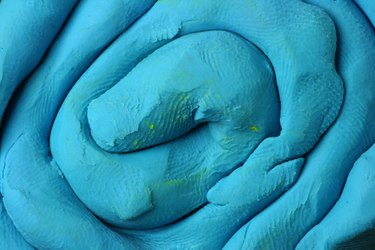Things You'll Need
Modeling Clay (six colors)
Floral wire
Floral stand
Toothpicks

DNA (deoxyribonucleic acid) is often referred to as the building block of life. The arrangement of bases on the deoxyribose-phosphate backbone provides the codes necessary for life processes. Studying the structure of the DNA molecule facilitates a greater understanding of DNA during transcription and replication, according to the U.S. National Library of Medicine. This understanding may be accomplished by creating a model of DNA allowing manipulation and a closer study of DNA. Colored modeling clay and floral wire provide readily available and inexpensive materials for construction of a DNA model.
Step 1
Decide on the colors to represent the major components of the DNA molecule. For example, black may represent the deoxyribose backbone, white the phosphate groups linking the deoxyribose, red for adenine, blue for thymine, green for cytosine, and yellow for guanine.
Video of the Day
Step 2
Roll the black clay (or whichever color was chosen for the deoxyribose) into three-quarter inch diameter balls. Roll the white clay (for the phosphate groups) into quarter-inch diameter balls.
Step 3
Slide the black and white clay balls onto the floral wire in an alternating sequence. Do the same to a second piece of floral wire. Both floral wires should begin with the same color of clay and the colors should align with each other when the clay covered floral wires are placed beside each other. There should be at least one inch of uncovered wire at the end of each floral wire when finished.
Step 4
Roll the red, blue, green and yellow clay into half-inch diameter balls. Slide these clay balls onto toothpicks so that a toothpick has both adenine and thymine, or cytosine and guanine representative clay balls. In the color scheme listed here, this corresponds to a red and blue ball or yellow and green ball on each toothpick. The bases should be near each end of the toothpick with the center of the toothpick bare.
Step 5
Insert a toothpick with the clay balls on it into a black clay ball near the end of the floral wire. Slide the other end of the toothpick into a matching black clay ball on the other floral wire.
Step 6
Continue to add the toothpicks to the DNA model, adding a slight twist between each toothpick. To represent DNA in a relaxed state, create one complete twist every 10 to 11 base pairs. Looking down the DNA molecule from the top towards the bottom, the top should be twisted in a counter-clockwise rotation.
Step 7
Carefully insert the exposed ends of the floral wire into the floral foam pad. The depth the wire needs to be inserted will depend on the length of the floral wire used. For large models, a dowel rod may be needed to add support to the DNA model.
Video of the Day